METU-NET (METU Campus Backbone Network) is accessible through dial-in services via:
1. PTT’s TURPAK (X.29),
2. Telephone Lines.
X.29 Access: Users can dial-in to METU-NET from any node on world-wide X.25 networks or PTT’s X.25 network (TURPAK) by using X.29 PAD dial-in technique. The X.25 DTE address of METU’s dial-in service is ‘4112102036’. Once a user gets connected to this service, a Unix login prompt welcomes him/her. METU Users should then login by using the following information:
login:metu
Password:MetuUser
It is then possible to get connected to any computer located on the METU-NET (and on the Internet) by entering the hostname (e.g. knidos.cc.metu.edu.tr, mozart.ceng.metu.edu.tr).
Telephone Lines: Users can dial-in to METU-NET by making ordinary phone calls. Following telephone numbers (with their attached modems) are available for our users:
Phone # Modem Type System
210 1121 14.4-1.2 (Auto-baud) Unix
210 1226 14.4-1.2 (Auto-baud) Unix
210 1227 2.4 (Fixed-baud) Banyan-Vines
210 1000
ext. 9560 Hunt Group for 9561-9565 Term. Server
ext. 9561 14.4-1.2 (Auto-baud) Term. Server
ext. 9562 14.4-1.2 (Auto-baud) Term. Server
ext. 9563 9.6 (Fixed-baud) Term. Server
ext. 9564 2.4 (Fixed-baud) Term. Server
ext. 9565 2.4 (Fixed-baud) Term. Server
Hot-Line for User Support
Users can call our new hot-line support (ext. 3355) for their urgent problems. Hot-line personnel will be available between 9:00-17:00 hrs, weekdays.
Campus PC Rooms
METU-CC makes Personal Computers (PCs) available in several PC rooms around the METU campus. Currently there are three rooms located in 1. Dormitory, 2. Dormitory, and Mechanical Engineering Department (A- 207). IBM 3270 terminal rooms in Civil Enginnering and Physics departments are going to be changing to PC rooms soon. PCs located in these rooms are served by Novell Netware servers and connected to the METU-NET via multi-protocol routers.
Windows 3.1
Excell 2.0
WinWord 2.0
Turbo Pascal 6.0
Borland C++ 2.0
Internet Tools (running under Windows 3.1)
a) World Wide Web Browsers
i) Mosaic ii) Cello
b) Gopher
c) FTP Programs
d) Telnet Programs (XWin, Wnqvtwsk)
e) 3270 Emulation Program (tn3270)
NCSA Applications (DOS)
DosLynx (WWW Browser for DOS)
Transfer of electronic data maintained on the old platform (Unisys A9F) to the new platform (Unisys U6000/65).
Printing of student information sheets (containing all available electronic data on each student's academic progress) for all registered students.
Design and printing of special information sheets to collect data which was previously unavailable in electronic form (like information on transfer students, special students, students benefiting from amnesty laws).
Examination and correction of student information sheets at the Registrar's Office.
Filling of special information sheets at the Registrar's Office.
Preparation of data entry programs and a special data entry database.
Data entry of both student and special information sheets to the new platform.
Design and implementation of a comprehensive data model for the ROAS database.
This data-collection phase was required due to the following facts:
The new data model urged the availability of a broader range of data on students in order to provide better service and lay ground for the future objectives of ROAS project.
Part of the electronic data on the old platform was out of date mainly due to the limitations of that platform like inflexible programming environment, lack of concurrent access to data, etc.
The timing was perfect for checking the accuracy of the data at hand since a similar operation is performed every semester by the Registrar's Office under the name of 'status operations'.
ROAS Objectives
The main objective of the ROAS Project is to provide the METU community with an easy-to-access, easy-to-use student information system. Knowing that this is not a trivial task, the project team defined several major milestones:
The Core System: The first and most important objective of the ROAS Project is the implementation of a so-called 'Core System' which will only provide those services provided by the old platform (in a much more accurate and timely manner). However, this core system will incorporate a very comprehensive and flexible data model and database structure in order to ease the implementation of features and services scheduled for later phases of the project.
Interactive Registration: This milestone marks the point in time when students will be able to register on-line through PC's/terminals across the university, academic and administrative staff will be able to access many services provided by the Registrar's Office through their PC's/terminals.
Enhancement and Expansion of Services: As the last major milestone, ROAS Project will aim at the enhancement of services (better user interfaces, client-server computing, etc.) and expansion of services (interaction with other information systems in the university, implementation of new services previously non-existent or unfeasible, etc.).
The ROAS platform
The ROAS project is currently under development on a Unisys U6000/65 machine running Unix operating system. The Informix relational database with 16-user license is used to develop the ROAS database system. The development platform will move onto a Sun SPARC 10/40 clone machine very shortly. This will be followed by start-up of the core system on the Unisys machine. The final platform for ROAS will be another Unix machine powerful enough to support hundreds of simultaneous users.
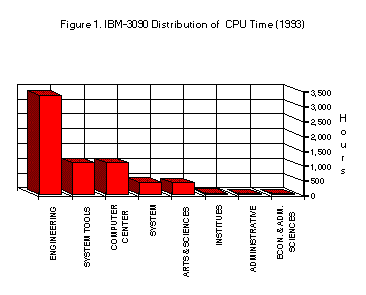
In Figure-1, the distribution of CPU hours in groups of user accounts is shown. Please note that the batch jobs submitted are accounted under the Computer Center since the batch userids in VM operating system are grouped under the Computer Center servis machines.

In Figure-2, a similar distribution for Vector Processor usage is shown.
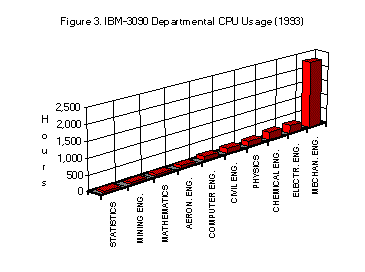
In Figure-3, the Top 10 Departments for CPU usage in 1993 is shown.

Figure-4 shows the number of vector processor hours used by departments.
METU-CWIS is designed on top of Network Information Retrieval Tools of Internet. A proprietary system is not chosen (or designed) for having a system that could be easily integrated to the rest of the world. One disadvantage of having a proprietary system is the fact that a proprietary system would be a product of a specific team (limited number of people, time, resources). Nevertheless, the common tools of Internet are 'living' products of the Net and getting more sophisticated and enhanced by people from all over the world by time.
The information presented in METU-CWIS is being served through a World Wide Web (WWW, W3) server. Some parts of the information is supplied by a Gopher Server and also the Wide Area Information Server (WAIS) is used for indexing some part of the information contained in METU-CWIS.
Why WWW ?
WWW is one of the most popular interactive network tools based on the client-server model: the user runs locally a client program that can communicate with a server program on a (remote) host computer. In order to access the information, the client sends the user's request to the server (using a standardized format called a protocol). The server handles the request and sends the response to the user.
The World-Wide Web has been described as a "wide-area hypermedia information retrieval initiative aiming to give universal access to a large universe of documents". It was designed at the European Centre of Particle Physics (CERN), Switzerland. Basically WWW and Gopher are similar: Both systems allow the user to browse information across the Internet without the necessity to login. However, WWW is much more powerful and flexible than Gopher. Whereas a Gopher menu is a list of items, WWW appears to the user as a text document and can take - provided that the user runs a graphical interfaces such as NCSA Mosaic - full advantage of text formatting. WWW documents are prepared in hypertext (i.e. text that contains links to other text). Selecting certain words within a WWW document via mouse or keyboard causes other documents to be opened, no matter where on the Internet these documents are. In addition, WWW documents can contain links not only to other text, but also to images, sounds and movies.
The rules that computers use to exchange messages are called protocols. Most network retrieval systems use their own protocol with limited access to other protocols. In contrast, the HTTP protocols used by WWW servers and clients allows to communicate to other systems including Gopher, WAIS, and FTP. Thus, WWW clients provide access to anything on:
WWW sites (> 400)
Gopher sites (> 1000)
WAIS sites (> 100)
anonymous FTP sites (> 1000)
Usenet News, etc.
This feature makes the WWW system one of the most comprehensive network retrieval tool. In addition, WWW clients are easy to use and - depending on the user's operating system - there are character based as well as graphical interfaces available.
Access to WWW Servers ...
To access information supplied by remote WWW sites you need a program (called WWW client or browser) that allows to communicate with the remote WWW server. The browser may either be locally installed or could be on a remote computer. If you are directly connected to the Internet it is recommended to install the client software locally. Disadvantages of accessing the Web by a remotely running client are lack of full functionality and poor performance.
You may want to try out what WWW looks like before installing a browser yourself. Fortunately, a browser program (namely lynx) is in public-use and configured to point to the METU-CWIS WWW server. To use this browser, enter the following command:
telnet info.metu.edu.tr
login: w3
password: metuinfo
Note: This program -lynx- is not working properly in IBM 3270 terminals in METU-CC Terminal Rooms. A WWW browser has already been installed in IBM 3090, enter www to run this browser, if you are on IBM 3090.
How to Install a WWW Browser:
If your computer is directly connected to the METU Campus Backbone Network (METU-NET) (If you are not sure about the connectivity of your department, please do not hesitate to send your questions to nwg@knidos.cc.metu.edu.tr.) and you want to use WWW, you should install a browser. The advantages of a locally running browser are full functionality and better performance. WWW browsers are available for most computing environments including:
MacOS 7.x
MS-Windows 3.1
MS-DOS (3.30+)
UNIX-based systems ( AIX, HP-UX, IRIX, OSF/1, Ultrix, Solaris, etc.)
X11/Motif
WWW browser software is copyrighted but usually free for academic use. The programs can be downloaded by anonymous FTP as C source code or in executable forms. Some of the available WWW browsers are listed below (there may be other software products that do the same job):
Lynx:
Lynx is a character-based browser that provides a full-screen interface for UNIX, DOS and VMS platforms. There is widespread agreement that Lynx is currently the best text-based browser. The files required (source files or binaries for IBM AIX, DEC Alpha OSF/1, Sun 4, Ultrix) to run this browser on your computer can be retrieved by anonymous FTP from
ftp.metu.edu.tr/pub/Internet/w3/lynx/
(i.e. /pub/Internet/w3/lynx directory on ftp.metu.edu.tr)
An alpha version of Lynx running under MS-DOS has been announced very recently. It can be retrieved by anonymous FTP from
ftp.metu.edu.tr/pub/Internet/w3/dos/
NCSA's Mosaic :
This is a graphical interface -developed in National Centre of Supercomputing Applications (NCSA), Illinois- for users on X-Windows, MacOS 7.x, and MS-Windows 3.x. Binaries for DEC Alpha, DEC Station, HP 9000/730, IBM RS/6000, Mac, PC Windows, SGI, Sun Solaris, Sun SunOS can be obtained from METU anonymous ftp archive (ftp.metu.edu.tr).
NCSA's Mosaic for X Windows provides a mouse-driven graphical interface for systems running X11/Motif. The files required to run this WWW browser on your computer can be retrieved by anonymous FTP from
ftp.metu.edu.tr/pub/Internet/w3/X/mosaic/
NCSA's Mosaic for the Apple Macintosh provides a WWW interface for Macs running System 7.x/MacTCP 2.0.2 (or later). The files required to run this WWW browser on your machine, can be received by anonymous FTP from
ftp.metu.edu.tr/pub/Internet/w3/mac/
NCSA's Mosaic for Microsoft Windows provides a graphical interface for IBM compatible PC's running Microsoft Windows 3.1 in 386 Enhanced Mode. NCSA's Mosaic for Windows is a WinSock (Windows Sockets) compliant application. Thus, a Winsock-compliant driver should exist in order to run NCSA's Mosaic for Windows. NCSA's Mosaic for Windows is not the only WinSock compliant application, in fact there are many others. Detailed information on WinSock is given in Introduction to Windows Sockets section.
Installing NCSA's Mosaic for Windows:
After installing the Windows Sockets to your PC, get the file
ftp.metu.edu.tr/pub/PC/winsock/mosaic.zip.
Copy this file to a directory 'c:\mosaic' and unzip it. Then, read all the README.* files; the installation is very easy and explained in these files.
Accessing Information via URLs ?
One of the most powerful aspects of the World-Wide Web is that it allows to access nearly any kind of data and network service. In order to locate such object on the Internet, the Web uses Uniform Resource Locators (URLs). URLs specify the access method, the address of the host computer, the port to connect to, and the path and name of the object. The format is:
accessmethod://hostname[:port]/path/objectname
Examples may look like this:
http://www.metu.edu.tr:80/ provides access to a WWW server on port 80
ftp://ftp.metu.edu.tr/ provides access to an anonymous ftp server
gopher://gopher.metu.edu.tr/ provides access to a gopher server
telnet://vm.cc.metu.edu.tr opens an interactive telnet session.
The URL for METU-CWIS is http://www.metu.edu.tr/. So, if you have already installed a WWW browser, use this URL to access the METU CWIS, e.g.;
for lynx, type
lynx http://www.metu.edu.tr/
for X-Mosaic, type
mosaic http://www.metu.edu.tr/
for Windows Mosaic, select the Open URL ...
item from File menu,
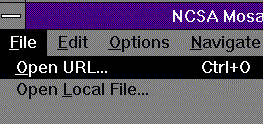
and type
http://www.metu.edu.tr/.
WWW browsers let you specify URLs either directly or by selecting hypertext in the WWW document you are presented with. This will cause the browser to send a request to open the URL specified. Selecting hypertext in a WWW document will take you to related information, which may also have pointers to related information. So don't worry if you don't know the URL of the information you want, simply follow the logical chain of hypertext links to get the information.
The Windows Sockets specification defines a standard, open network programming interface for Microsoft Windows and Windows NT which is based on the "socket" paradigm popularized in the Berkeley Software Distribution (BSD) from the University of California at Berkeley for Unix-based systems..
Q. What is the history and current status of Winsock ?
Windows Sockets grew out of a confluence of interests and technologies. The burgeoning success of Microsoft Windows, the continuing growth in the prevalence and significance of TCP/IP networking and the corporate requirement for open software standards, all came together to create an environment which was ready and waiting for the Windows Sockets standard. Currently, Windows Sockets version 1.1 serves as the authoritative, complete version of the Windows Sockets API for the TCP/IP protocol family.
Q. What does "Windows Sockets Compliant" mean ?
Network software which conforms to the Windows Sockets specification will be considered "Windows Sockets Compliant". Suppliers of interfaces which are "Windows Sockets Compliant" shall be referred to as "Windows Sockets Suppliers". To be Windows Sockets Compliant, a vendor must implement 100% of this Windows Sockets specification.
Q. Where can I get a WINSOCK.DLL ?
Windows Sockets comes as a Windows Dynamic Link Library (DLL), namely WINSOCK.DLL. If you are already using a TCP/IP software (like PCTCP, PC/NFS, LWP etc.) you should first contact the vendor from whom you obtained your TCP/IP software. For Example, PC/TCP 2.20 distribution comes with a WINSOCK.DLL. There is also a shareware WinSock called "Trumpet Winsock" that provides a connection layer between Windows and the underlying DOS packet driver for your network board.
Q. Do I need a TCP/IP already to use it?
Yes. A WINSOCK.DLL is just an interface to whatever existing TCP/IP you already have installed.
Q. Why isn't there just one WINSOCK.DLL? Do I need a TCP/IP already to use it?
The Windows Sockets specification defines the top level of the DLL, the part which is called by user programs. The method a given WINSOCK.DLL will use to access TCP/IP (or NetWare, or AppleTalk, or DECNet ...) depends on the networking package you have installed, and therefore must vary. A WINSOCK.DLL is therefore just an interface to whatever existing protocol you already have installed. The following illustration may help:

For example, Running NCSA Mosaic for Windows with PCTCP 2.20 and Banyan Vines on a PC with NE1000 Network card, the illustration looks like;

Running NCSA Mosaic for Windows with shareware Trumpet WinSock on a PC with a NE1000 Network card, the illustration looks like;

Q. How do I obtain and install the Trumpet Winsock driver ?
If you don't have a registered copy of a commercial TCP/IP Package (e.g. PC/TCP) installed on your PC, you can use the Trumpet WinSock Package. Note that this Winsock driver is NOT freeware but is distributed under the shareware philosophy. You can get the Trumpet Winsock from;
ftp.metu.edu.tr/pub/PC/winsock/twsk10a.zip
Follow the steps given below to install the Trumpet Winsock in your PC;
add the Winsock directory to your path list in the "autoexec.bat",
add a line in your autoexec.bat that will load the Winsock driver immediately after your DOS packet driver ( The user can get the packet drivers from ftp.metu.edu.tr under the path /pub/PC/packet/pktd11.zip );
e.g.: c:\winsock\winpkt.com 0x60
(make sure to supply the same software interrupt number that you gave to the DOS packet driver -given the assumption above, the "packet vector" would be "60"-)
reboot and check whether both drivers load successfully,
start Windows and add "tcpman.exe" as a new program item,
double click "Tcpman" and enter the information being asked for (you may need some assistance in this step, ask for your network administrator or to nwg@knidos.cc.metu.edu.tr).
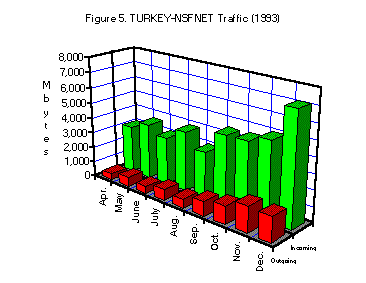
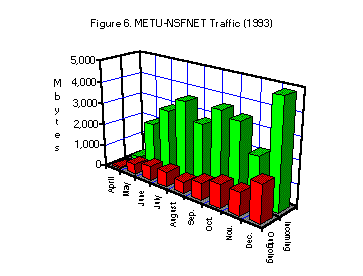
Figure-5 shows total traffic between Turkey and NSF, while Figure-6 shows METU’s international traffic.
NOVELL SEEKS TO SELL UNIX SOURCE LICENSES. Novell is talking with several computer makers about selling "source licenses" to its Unix program. Proceeds from the sale of licenses could bring in more than $100 million. Although the new arrangement would mean a big up-front payment for license buyers, it would mean that Unix customers would no longer have to pay royalties on an annual basis. (Wall Street Journal 2/18/94 B3)